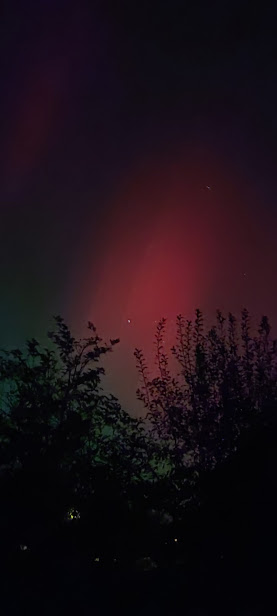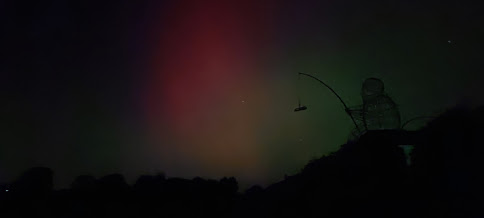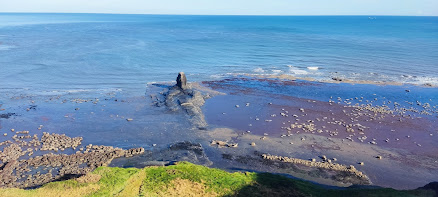A wingbarred Phylloscopus warbler at Bempton Cliffs had set pulses racing earlier this week, but due to poor weather and its skulking, elusive behaviour, it had evaded identification. Having heard an unusual call, local birders had their suspicions, and by Friday, the bird had been recorded and an identification reached: this was Britain's second ever Pale-legged Leaf Warbler, and the first to be found alive! This little bird had gone a long, long way wrong; it should be heading to its wintering grounds in Burma and Thailand, not East Yorkshire. This really was an uber-vagrant of a Giga-level rarity.
Old mate Philip was up for our birthday gathering and we had planned to go birding at Flamborough this morning, so this couldn't have been timed better! However, with the first clear weather for a few days overnight, I felt there was a chance the bird would depart. As we headed east early doors, I was drawn to the Flamborough fog station (ironically, as it's job is to deter) as I felt that yesterday's strong northerly wind could well generate a really exciting seawatch today. Also, the Bempton warbler had been reported to be extremely elusive and combined with the sheer rarity of this bird, there was likely to be a big crowd gathered, jostling for views, and I was really unsure whether I could face that!
We were still debating this as we drove into Bridlington, but news of the bird's continuing presence eased our decision and we hung a left and gunned the car to Bempton. About 100 birders were already present and volunteers were doing a great job of directing the arriving and very anxious twitchers, ably assisted by some of the Flamborough Bird Obs folk. We parked up and made our way to where the bird had last been seen. A crowd had gathered, six or seven deep, staring intently into the shadowy depths underneath some large Hawthorns. Unlike most leaf-warblers, this species apparently likes it low down and shady, hanging out in the brambles and lower parts of bushes; this was going to be tricky. Birders were kneeling down at the front of the scrum, almost as if paying homage to the bird! I wandered to the back of the crowd, but there was no way I was seeing anything through the tiny gaps between birders heads. It was like being at a gig, just with the stage being a bank of bushes. We decided a better bet would be to go round the other side of the Dell (a large sort of depression lined with Brambles, Gorse, Bracken and Nettles and studded with large Hawthorns and a few larger trees. The sun was shining on to the opposite bank, and it was nice and sheltered too, perfect for a feeding vagrant warbler. A Siberian-type Lesser Whitethroat leapt out of a nearby bush as if to prove the point.
Nerves were rattled by any small movement; Goldcrests zipped around a large Sycamore; Blackcaps guzzled Elderberries; a rather grey Chiffchaff flitted through the Willows and finches and Tree Sparrows were all busily feeding in the Dell. Despite the plan, after twenty minutes of so, excited movement from the twitchers on the other side suggested that the bird may have reappeared round the other side.
The rather brown-naped Lesser Whitethroat in the Dell.
We headed back to the burgeoning crowd and after a few tense moments, the strange, high-pitched 'tink' of the Pale-legged Leaf Warbler could be heard. The call was really distinctive, sounding almost tree frog-like. Moments later, the warbler flicked up from the unseen darkness under the bush into the higher twigs of the canopy and then flicked across the top and down into the Dell! We shot back round to the entrance road and could still hear the warbler calling. It was getting closer and Philip suddenly exclaimed that he had the bird low down in the Hawthorn on the side of the Dell. I got my bins on it just as it flicked off into the Brambles. Drat! The bird melted away. We changed position to see if the bird would reappear but it somehow moved quickly back to the other side of the Dell - we could track it by its call. We headed back to the car park and sure enough the bird flew across the road into the large bushes close to the visitor centre. Yet again, I got close views of the bird flicking low down in the bushes, but just could not get it on it well enough. All the time, the distinctive call was given. It then flew straight over my head into the scrub just next to the visitor centre. It stopped calling and was lost.
The penetrating thin call of a Yellow-browed Warbler was a welcome distraction; it showed well feeding actively in a nearby Ash. We wondered if the bird had moved along the wooded belt to the north, so we headed along looking and listening intently. We picked up two more Yellow-browed Warblers, one either side of the pond; lovely little sprites dashing about the Willows and Alders. One or two Song Thrushes were in the willows too.
Shiny sprites
After more searching, we debated whether this was all we were going to see of the PLLW. Philip was happy, I wasn't particularly; I had seen the bird five or six times and listened to its call, but had not seen it properly through my bins. We debated options and then suddenly we heard it call again moving back towards its original spot. It was clearly doing a feeding circuit, following a regular route around the scrubby areas surrounding the car park and Dell. Discussing tactics, we felt our best chance would be to wait until the bird was in its original spot, then head round to the entrance track and wait. Following it around with the crowd was just proving to be frustrating, so getting ahead and quietly waiting near a likely spot, could just pay off, if it chose to repeat what it had done an hour previously.
One or two birders had the same idea, and a small group of us gathered by the roadside at the foot of the Dell. Tense minutes passed by and then, we heard the sound of the bird as it approached unseen through the bushes. Philip, who is blessed with the sharpest eyes of anybody I know, spotted it first as it flicked into the side of a Hawthorn. I didn't see it, but focussed by bins into the area. And suddenly, out it hopped, on to a small bare branch in a hole in the Hawthorn! Facing left, it nervously flicked its wings and tail, whilst looking around. It was a noticeably large Phyllosc, with bright white supercilium and white throat, a dark greyish head and olive mantle with bright bronzy wings, with indistinct wingbars, and of course, pale pink legs! It hopped left and out of sight, before revealing itself again. Our hunch had paid off and we had enjoyed good views of the bird doing its thing as it moved through the scrub.


Pale-legged Leaf Warbler, Bempton: Photos by Steve Williams @steveonhilbre.bsky.social - thanks Steve for letting me use your pics :-)
To our surprise, it then flicked across the road into the bushes on the western edge of the site, just as the masses arrived from the northside of the Dell. The crowd gathered, blocking the road, and we retreated for coffee and cake, smiles gleaming in the morning sunshine.
Caffeine-fuelled, we walked the cliffs to North Dykes, where a Siberian Stonechat was flycatching from a barbed wire fence in the company of a Whinchat. The bird was a typical pale Maurus type with pale unstreaked peachy uppertail and a frosty look.
Siberian Stonechat
A couple of lovely Pink-feet flocks winked overhead as they winged their way south, and Gannets cruised past along the clifftops as we wandered back, in that elated mood generated by having seen something really special and having had some very nice cake. There was more mouth-watering news coming out of Flamborough, and I was desperate to try and find our own birds, but we had a party to prepare, so we left the throngs searching for the East Asian skulker and headed back west.
Fresh in from Iceland, Pink-footed Geese heading south across the blue skies above Bempton.















.jpg)

.jpg)









































